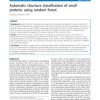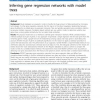BMCBI
2010
13 years 11 months ago
2010
Background: Random forest, an ensemble based supervised machine learning algorithm, is used to predict the SCOP structural classification for a target structure, based on the simi...
BMCBI
2010
13 years 11 months ago
2010
Background: Today, data evaluation has become a bottleneck in chromatographic science. Analytical instruments equipped with automated samplers yield large amounts of measurement d...
BMCBI
2010
13 years 11 months ago
2010
Background: Mass spectrometry is an essential technique in proteomics both to identify the proteins of a biological sample and to compare proteomic profiles of different samples. ...
BMCBI
2010
13 years 11 months ago
2010
BMCBI
2010
13 years 11 months ago
2010
Background: High throughput sequencing has become an increasingly important tool for biological research. However, the existing software systems for managing and processing these ...
BMCBI
2010
13 years 11 months ago
2010
Background: Novel strategies are required in order to handle the huge amount of data produced by microarray technologies. To infer gene regulatory networks, the first step is to f...
BMCBI
2010
13 years 11 months ago
2010
Background: Data generated using `omics' technologies are characterized by high dimensionality, where the number of features measured per subject vastly exceeds the number of...
BMCBI
2010
13 years 11 months ago
2010
Background: Microevolution is the study of short-term changes of alleles within a population and their effects on the phenotype of organisms. The result of the below-species-level...
BMCBI
2010
13 years 11 months ago
2010
Background: The binding of regulatory proteins to their specific DNA targets determines the accurate expression of the neighboring genes. The in silico prediction of new binding s...
BMCBI
2010
13 years 11 months ago
2010
Background: There is an increasing demand to assemble and align large-scale biological sequence data sets. The commonly used multiple sequence alignment programs are still limited...





